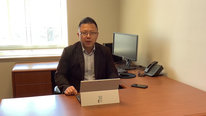
MATT WHITTAKER
ASSisT: Alliance to Strengthen the STEM Tapestry
NSF Awards: 1649161
2017 (see original presentation & discussion)
Grades 9-12, Undergraduate, Adult learners, Informal / multi-age
Our project focuses on the STEM-disenfranchised--those individuals who feel alienated, marginalized, or incapable of participating in STEM. Our alliance of organizations across the Salt Lake Valley and beyond will work with individuals at the University of Utah to provide STEM engagement opportunities to three distinct cohorts--previously incarcerated youth, previously incarcerated adults, and refugee youth. Through a series of novel interventions, we are attempting to measure individuals' shift in science-identity and self-efficacy. Our interventions are 1) ecological restoration, which will connect participants with science in a hands-on way; 2) devised theater, which will provide participants the opportunity to create an original, unscripted theater piece as it pertains to their science identity; and 3) self narrative--the process of self-reflection as it relates to previously engagement (or lack there of) with the scientific enterprise, either through the other interventions, or in their personal past. It is through these interventions will aim to measure and evaluate if a transformation in one's self-identity as it relates to science will occur, and how these participant's "see themselves" before, during, and after engaging with these innovative approaches to STEM.
Related Content for ASSisT: Alliance to Strength the STEM Tapestry
-
 2018RAISE: STEM Career Development for Incarcerated Youth
2018RAISE: STEM Career Development for Incarcerated Youth
Karen Harrington
-
 2020STEM Opportunities in Prison Settings (STEM-OPS)
2020STEM Opportunities in Prison Settings (STEM-OPS)
Eden Badertscher
-
 2021INSITE: Understanding STEM Career Readiness of Incarcerated
2021INSITE: Understanding STEM Career Readiness of Incarcerated
Heather Griller Clark
-
 2018STEPs to STEM
2018STEPs to STEM
Jill Stockwell
-
 2020INSITE: Exploring STEM Careers with Incarcerated Learners
2020INSITE: Exploring STEM Careers with Incarcerated Learners
Heather Griller Clark
-
 2022STEM Opportunities in Prison Settings
2022STEM Opportunities in Prison Settings
Terrell Blount
-
 2022Sailing into STEM with Guam NSF INCLUDES SEAS and EPSCoR
2022Sailing into STEM with Guam NSF INCLUDES SEAS and EPSCoR
Kyle Mandapat
-
 2021Measuring PCK of Questioning in introductory physics classes
2021Measuring PCK of Questioning in introductory physics classes
Jianlan Wang
William McHenry
Executive Director
Great project. The research and evaluation elements of the Alliance to strength the STEM Tapestry should yield valuable knowledge on how to effectively reach this population. How do you determine eligibility for the project?
Matt Whittaker
Matt Whittaker
Program Manager
Great question! Given the sensitive nature of working with these affected groups, we are still in the process of finalizing those details with our community partners regarding how their recommendations in identifying participants/establishing and maintaining contact with each cohort should be approached. As that information continues to trickle in over the next few weeks, we should be better able to effectively answer that question.
Thanks!
-Matt
Sharon Lynch
What an interesting project and a real need for the large numbers of incarcerated people who need to find a way to re-enter the community. STEM skills seem like a good way back in.
Any longitudinal data?
Thanks.
Matt Whittaker
Matt Whittaker
Program Manager
Thanks for the comment and question! No project-specific longitudinal data exists for post-release populations. Our hope to is to use this pilot in establishing a baseline.
Cheers!
-Matt
Jake Foster
Congratulations on beginning this a unique program with a such a high-need population. Changing an individual's relationship with STEM certainly can have positive benefits. What would you consider a success for this work -- is changing their STEM identity enough, even if they don't pursue STEM in a significant way after participation, or would you expect success to include further pursuit of STEM studies or career options?
Matt Whittaker
Program Manager
Great question! For us, the central idea is more the former than the latter. We want to better understand the STEM tapestry from the perspective of an individuals identity within STEM (whatever that may or may not be), as opposed to just working to connect these folks to STEM study and careers. However, that's not to say that the latter is not a welcome outcome.
Thanks again!
-Matt
Heidi Schweingruber
Director
Really interesting project. How did you develop the model and the three components? The theater and self-narrative strike me as particularly innovative in relation to STEM and I'm curious about how you identified them as potential strategies for connecting people to STEM. Also, how are you framing "science" in the context of the project and how do you help participants make connections to it? Particularly for the self-narrative and the ecological reconstruction?
Matt Whittaker
Program Manager
Janet Yowell
Hi Matt,
I just wanted to say again how interesting I think your project is (I innudated you with accolades in DC last month and bent your ear). Great video (although you mentioned it was before you, it's still awesome!).
I wanted to encourage you to reach out to the Alexis Petri who is with the UK-Missouri INCLUDES project, as they have a connection with seasoned storyteller, Laura Packer, who is great at teaching/guiding storytelling mentors on how to think about and weave STEM into stories. Alexis may have some information she can forward you on the art.
Just an FYI.
Matt Whittaker
Program Manager
Thanks so much, Janet! And thank you for this recommendation. Sounds like a great connection!
Cheers,
Matt
Further posting is closed as the event has ended.